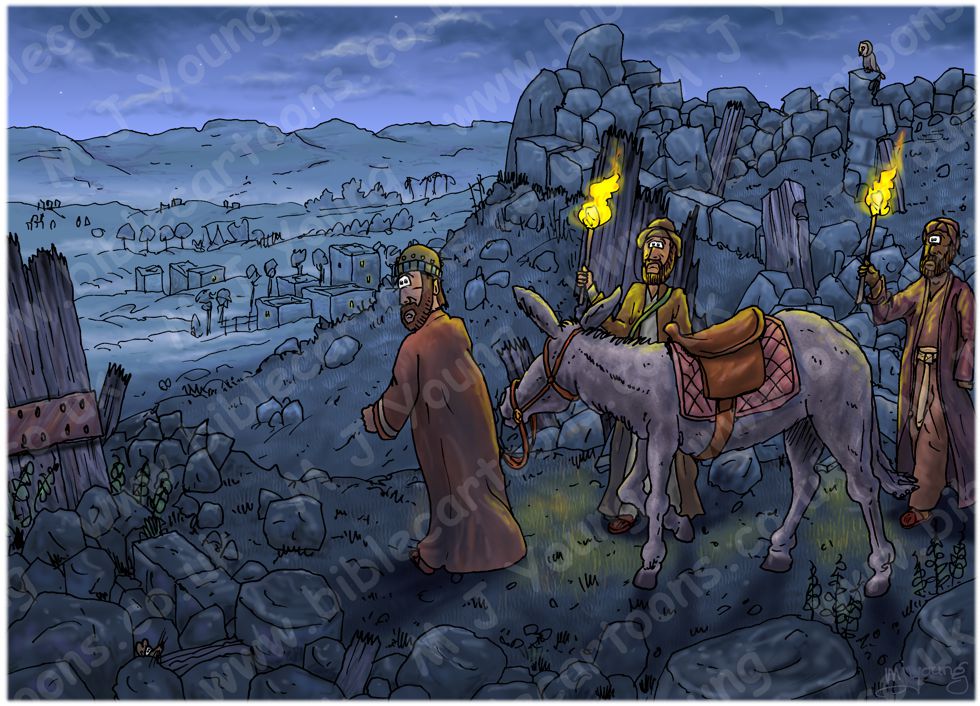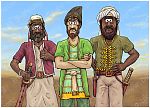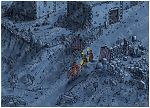Bible Cartoon: Nehemiah 02 - Nehemiah inspects Jerusalem's walls - Scene 01 - Through the Valley Gate
Click on Add to cart button below shopping cart.
Purchased Bible Cartoons do not have watermarks. Links to Cartoons provided on email once purchase is completed.Bible Book: Nehemiah
Bible Book Code: 1600201101
Scene no: 1 of 6
Bible Reference & Cartoon Description
Nehemiah 2:11-13a (ANIV)
Nehemiah inspects Jerusalem’s walls
11 I went to Jerusalem, and after staying there three days 12 I set out during the night with a few men. I had not told anyone what my God had put in my heart to do for Jerusalem. There were no mounts with me except the one I was riding on.
13a By night I went out through the Valley Gate… [towards the Jackal Well and the Dung Gate, examining the walls of Jerusalem, which had been broken down, and its gates, which had been destroyed by fire.]
DRAWING NOTES:
TIME OF DAY:
Verse 12 tells us Nehemiah went out at night.
LIGHTING NOTES:
There are two sources of light in this scene. The first is the full moon (unseen, behind the viewer) which gives a cool, blue hue to the landscape. The second is a warm, yellow/orange light coming from the two torches Nehemiah’s companions are carrying.
CHARACTERS PRESENT:
Nehemiah is leading his donkey towards the remains of the Valley gate. Behind him are his two un-named companions.
RESEARCH/ADDITIONAL NOTES:
This picture shows Nehemiah leading his donkey from inside Jerusalem towards the broken walls and remains of the Valley Gate. The only bit of that gate which remains are the two bronze bound wooden gates, which are in the left and right foreground of my picture. Beyond the broken gateway is a steep slope leading down to the Hinnom valley. The remains of Jerusalem’s broken down walls can also be seen in this picture. I enjoyed drawing and colouring up a night scene, with moonlit mist in the distance, and the contrast between the cool blues and warm yellows of the torches carried by Nehemiah’s companions.
Notice that Nehemiah has discarded the Persian clothing I drew him wearing in previous scenes. I reasoned that once he had returned to Jerusalem, and was among his own people once more, Nehemiah might prefer to wear the clothing of his fellow Jews, rather than standing out in his Persian court clothing. I decided Nehemaih might keep his Persian court hat, as a sign of his loyalty to the Persian king.
The Valley gate was on the western side of Jerusalem, a bit more than half way from the northern most walls & the southern most walls of the city. Nehemiah turned south, going along the Hinnom valley, down to the Dung Gate, which is located at the southern most point of the city.
Notice the little mouse poking its head out from the rubble in the bottom left corner, and the owl, perched on some stone in the top right corner… probably looking for the mouse!
Here’s the scene without the figures or donkey included.
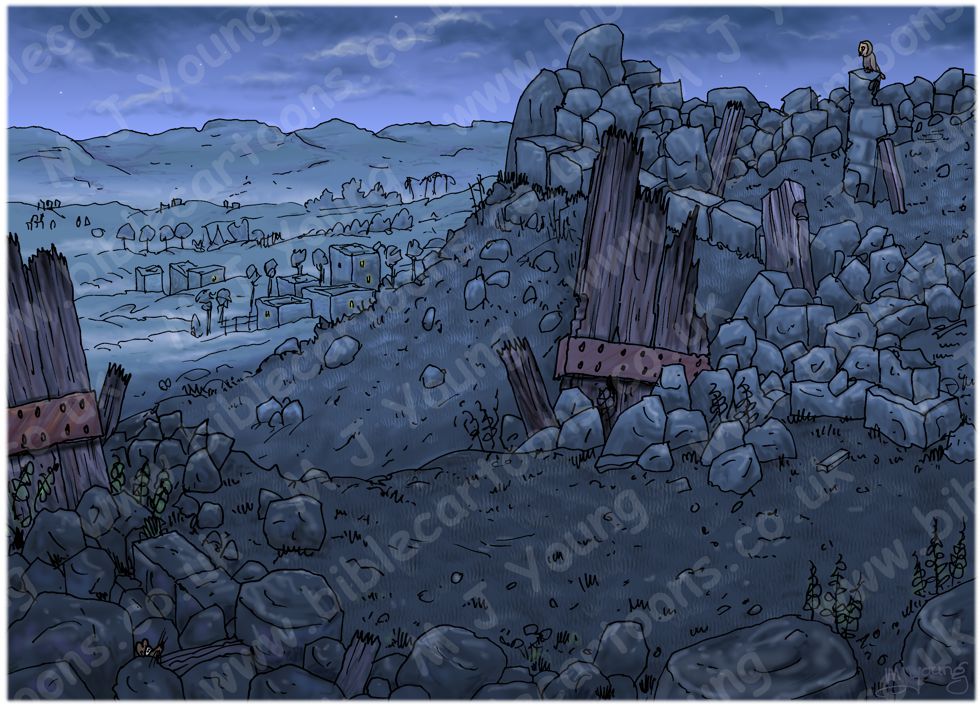
Background of Nehemiah 02 – Nehemiah inspects Jerusalem’s walls – Scene 01 – Through the Valley Gate
Click on the colour bar below to view/buy this Background:
Background of Nehemiah 02 – Nehemiah Jerusalem’s walls – Scene 01 – Through the Valley Gate
Here’s the rough pencil sketch I drew for this scene.
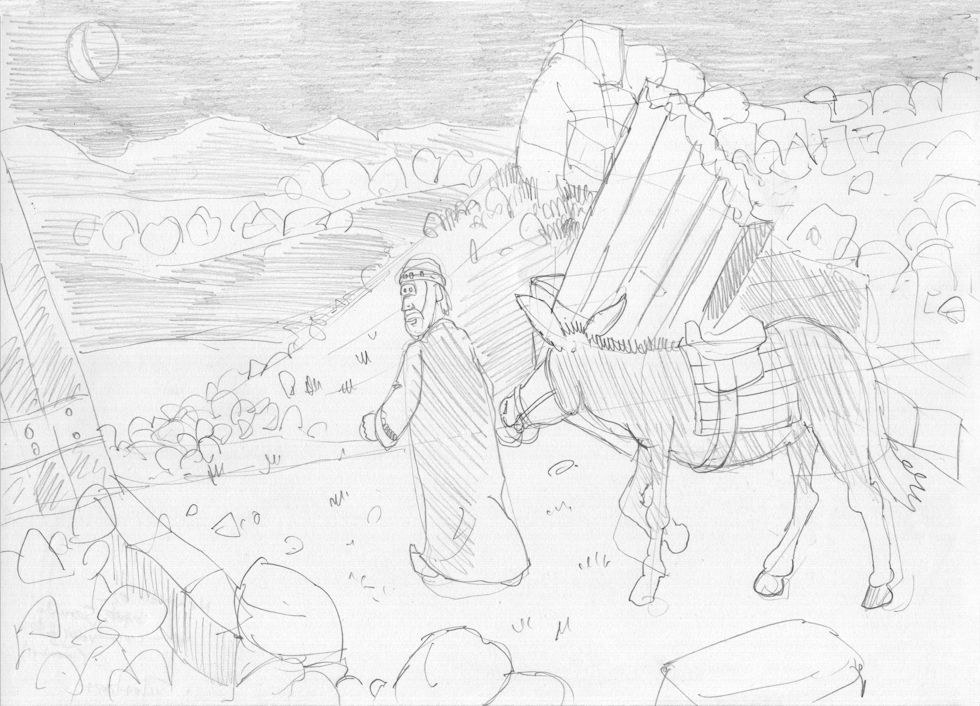
Nehemiah 02 – Nehemiah inspects Jerusalem’s walls – Scene 01 – Through the Valley Gate – greyscale
Here’s a plan view of the walls of Jerusalem at the time of Nehemiah, showing his route through the remains of the Valley Gate, southwards, towards the Dung Gate.

The Walls of Jerusalem Map – Nehemiah 02 – Valley Gate Route
Click on the colour bar below to view/buy this Map (Note – bought map has no watermark):
Map of the Walls and Gates of Jerusalem: Nehemiah’s route through the Valley gate, towards the Dung Gate
The Valleys of Jerusalem
Around and across Jerusalem are three valleys: the Tyropoeon Valley which bisects the city from its centre to the south-east corner; the Kidron Valley separating the eastern side from hills of the Mount of Olives region; and the Hinnom Valley, now thought by most scholars to be the valley curling round the south-west side of Jerusalem. Each of the three terminates near Siloam. The Valley Gate, it is fairly certain, led to the Valley of Hinnom. The walls, joined on one side to the Old Gate, were connected on the other to the Dung Gate.
In Jeremiah’s time the Hinnom Valley was associated with the worship of Molech and other gods, with a shrine that was destroyed by King Josiah. Later the valley was the place for burning refuse and corpses of criminals and animals, until its name became used as a symbol of hell (ge = valley, Hinnom, as e.g. Josh. 15:8, Neh. 11:3, hence ‘Gehenna’.) With the use to which this valley was put, it is quite appropriate to think of this gate as ‘humility.’
[Source: https://www.christianstudylibrary.org/article/gates-jerusalem-valley-gate]
Topical Encyclopedia
The Valley-gate is a significant location mentioned in the Bible, particularly in the context of the rebuilding of the walls of Jerusalem during the time of Nehemiah. This gate is one of the several gates of Jerusalem that played a crucial role in the city’s defense and daily life.
Biblical References:
The primary reference to the Valley-gate is found in the book of Nehemiah. Nehemiah 2:13 states, “So I went out at night through the Valley Gate toward the Well of the Serpents and the Dung Gate, and I inspected the walls of Jerusalem that had been broken down and the gates that had been destroyed by fire.” This passage highlights Nehemiah’s inspection of the city’s walls, emphasizing the Valley-gate as a starting point for his survey.
Further mention is made in Nehemiah 3:13 , which records the efforts to rebuild the gate: “Hanun and the residents of Zanoah repaired the Valley Gate. They rebuilt it and installed its doors, bolts, and bars, as well as repairing a thousand cubits of the wall to the Dung Gate.” This verse underscores the collaborative effort of the people in restoring the gate and the adjacent sections of the wall, reflecting the communal spirit and dedication to the restoration of Jerusalem.
Historical and Geographical Context:
The Valley-gate is believed to have been located on the western side of Jerusalem, opening towards the Valley of Hinnom. This valley, known for its historical and prophetic significance, served as a boundary and a natural defense for the city. The gate’s strategic position allowed for access to the surrounding valleys and facilitated movement and trade.
In the context of Nehemiah’s time, the Valley-gate was part of the extensive reconstruction project aimed at restoring Jerusalem’s fortifications after the Babylonian exile. The rebuilding of the gate was not only a physical restoration but also a symbolic act of renewal and faithfulness to God’s promises.
Theological Significance:
From a theological perspective, the Valley-gate represents themes of restoration, vigilance, and community effort. The rebuilding of the gate and the walls of Jerusalem under Nehemiah’s leadership is often seen as a testament to God’s faithfulness and the people’s commitment to His covenant. It serves as a reminder of the importance of spiritual and communal renewal, as well as the need for vigilance in protecting what is sacred.
The Valley-gate, like other gates of Jerusalem, also holds eschatological significance. In prophetic literature, the restoration of Jerusalem is often associated with the coming of God’s kingdom and the fulfillment of His promises to Israel. Thus, the Valley-gate stands as a symbol of hope and divine intervention in the history of God’s people.
Conclusion:
The Valley-gate, while a specific and localized feature of ancient Jerusalem, carries with it a wealth of historical, cultural, and spiritual meaning. Its mention in the book of Nehemiah highlights the themes of restoration and faithfulness that are central to the biblical narrative. Through the efforts to rebuild this gate, the people of Jerusalem demonstrated their dedication to God and their hope for a renewed future.
[Source: https://biblehub.com/topical/v/valley-gate.htm]
Jackal’s Well – (`en ha-tannin; Septuagint has pege ton sukon, “fountain of the figs”; the King James Version dragon well): A well or spring in the valley of Hinnom between the “Gate of the Gai” and the Dung Gate (Neh 2:13). No such source exists in the Wady er Rababi (see HINNOM, VALLEY OF) today, although it is very probable that a well sunk to the rock in the lower parts of this valley might strike a certain amount of water trickling down the valley-bottom. G.A. Smith suggests (Jerusalem, I, chapter iv) that this source may have arisen as the result of an earthquake, hence, the name “dragon,” and have subsequently disappeared; but it is at least as likely that it received its name from the jackals which haunted this valley, as the pariah dogs do today, to consume the dead bodies which were thrown there.
[Source: https://classic.net.bible.org/dictionary.php]
